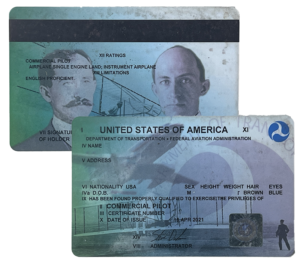Become a Pilot
The Private Pilot Certificate
What does it take to become a private pilot?
- You need to be at least 17 years old and able to read, speak write and understand the English language.
- You can solo an airplane in the United States at 16, but you must be 17 to hold the license.
- You should be prepared to invest between $10,000 and $14,000 to earn the license.
- Your flight training will take place over a period of five to seven months with two to three flight lessons per week before you’re ready for your private pilot check ride.
- Your first 10 to 20 hours will be dual instruction with an instructor preparing for solo flight. Once that’s complete you’ll learn about navigation and cross country flying.
- During this time, you will need to pass the 60-question FAA private pilot multiple choice examination.
- Finally you will take flight test, called a practical test, with a FAA designated pilot examiner. After passing that test, you’re a private pilot!

What can I expect to invest for a private pilot certificate? The cost depends on how many hours it takes and the cost of the airplane rental per hour.
- Students who fly two to three times per week will take significantly less total time to learn than those who fly only once or twice a month.
- Scheduling is more difficult in winter months due to the weather and Fall is a wonderful time to fly.
- Aircraft rental rates range from $120 per hour for a simple two-seat Cessna 150 to $330 per hour for a multiengine airplane.
- The FAA minimum requirement is 40 hours of flight time with 20 hours of that time with an instructor and 10 hours solo flight time.
- Most pilots take 10 to 20 additional hours to be fully prepared for the checkride.
The following chart is a reasonable estimate of what you can expect to invest.
| Rate | Cost | |
|---|---|---|
| 40 hours of airplane rental | $125 | $5000 |
| 20 hours additional rental | $125 | $2500 |
| 40 hours flight instruction | $50 | $2000 |
| 40 hours ground instruction | $50 | $2000 |
| Medical examination | $150 | |
| Written exam fee | $175 | |
| Designated Examiner Fee | $500 | |
| Online Ground School | $300 | |
| Additional Supplies | $200 | |
| Total | $12,825 |
What does a Private Pilot Certificate Allow You to Do? A private pilot certificate, also known as a private pilot license (PPL), allows you to fly an aircraft for personal and non-commercial purposes. Here’s what a private pilot certificate typically allows you to do:
-
Fly an Aircraft: With a private pilot certificate, you can act as the pilot-in-command (PIC) of an aircraft. This means you can operate the aircraft’s controls and make decisions regarding the flight.
-
Carry Passengers: You can carry passengers in the aircraft, as long as the flight is not conducted for compensation or hire. In other words, you cannot charge passengers for the flight but you can share expenses equally.
-
Fly Cross-Country: You are allowed to fly aircraft on cross-country flights, which generally involve flying between different airports or locations.
-
Fly During Day and Night: A private pilot certificate typically allows you to fly during both daytime and nighttime conditions provided that you meet currency requirements.
-
Fly Different Types of Aircraft: The certificate applies to a specific category and class of aircraft, such as airplanes, helicopters, or gliders. If you hold a private pilot certificate for airplanes, you can fly different types of airplanes within that category but it’s common to receive a checkout from an instructor in a new aircraft.
-
Continue Training and Gain Additional Ratings: A private pilot certificate serves as a foundation for further aviation training. If you wish, you can pursue additional pilot ratings, such as an instrument rating, commercial pilot certificate, or flight instructor certificate.
It’s important to note that a private pilot certificate does come with limitations. Specifically, you cannot use it to engage in any kind of commercial flying, such as carrying passengers or cargo for compensation. To do that, you would need to obtain a commercial pilot certificate, which involves meeting more stringent training and experience requirements.
Private Pilot Resources
- Printed FAR/AIM book from Sportys
- FAA Pilot’s Handbook of Aeronautical Knowledge
- FAA Airplane Flying Handbook
- FAA Flight Plan Form (for VFR search and rescue flight plan)
- FAA Private Pilot Airman Certification Standards (ACS)
- King Schools Private Pilot Syllabus